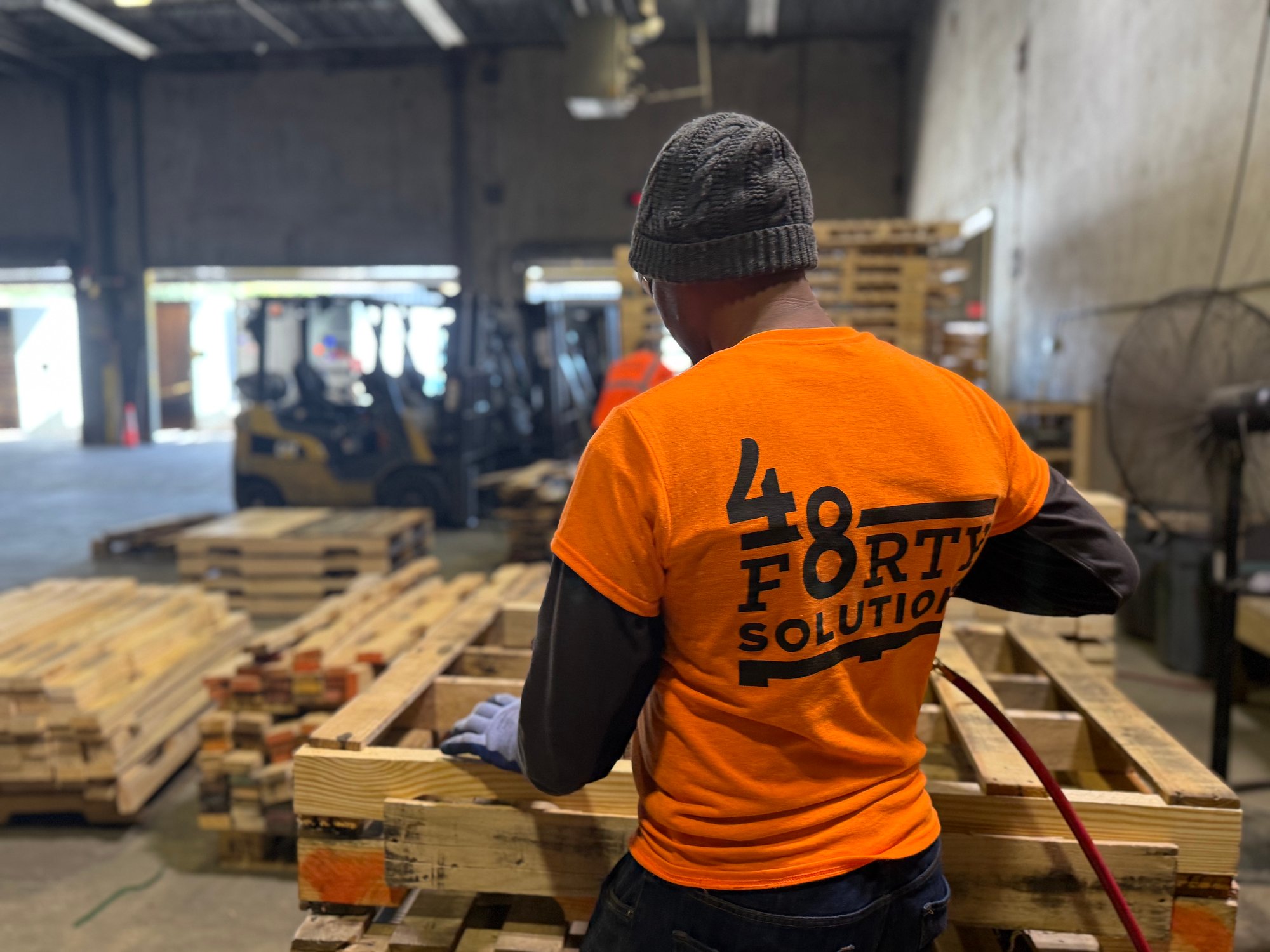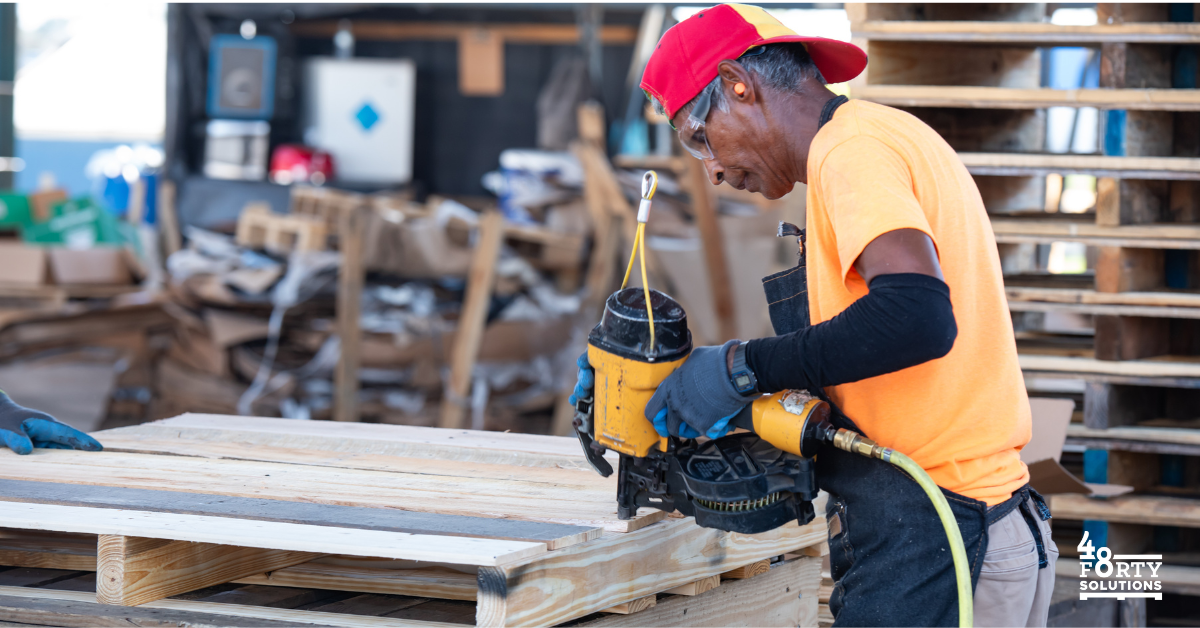Pallet Damage Prevention Tips for Improved Supply Chains
Why Pallet Damage Prevention Is a Supply Chain Priority

In any modern supply chain, pallets do more than move products—they move business. But when industrial pallets are damaged, the cost affects more than your materials. It slows your operations, increases safety risks, and triggers preventable delays throughout your network. Whether you're moving products across town or across the country, pallet damage prevention should be part of your core logistics strategy.
At 48forty Solutions, pallet integrity is at the heart of what we do. As North America's largest pallet management services company, we manage the full lifecycle of millions of pallets each year. One thing is sure—early investment in pallet repair, handling practices, and quality control pays off in reduced downtime, better customer satisfaction, and a more resilient supply chain.
The Real Cost of Damaged Pallets
A cracked board or splintered stringer might seem minor. However, the impact can ripple across your entire operation when it results in a collapsed pallet load.
Here’s what’s at risk:
- Product damage due to shifting or instability
- Worker injury from falling loads or handling broken pallets
- Lost time on the dock or in transit due to rework or replacement
- Higher costs from reorders, rushed shipments, or emergency procurement
- Decreased asset lifespan, leading to higher pallet spend over time
The solution isn’t just buying more pallets—it’s building a damage prevention strategy into every touchpoint of the supply chain.
1. Prioritize Quality from the Start
Prevention starts with sourcing. Low-quality pallets are likelier to break under load, especially in high-turn or high-impact environments.
That’s why many of the most efficient supply chains rely on 48forty’s recycled and repaired pallets, which are graded and inspected for structural integrity at every stage. Our facilities are equipped to assess, refurbish, and return pallets to service quickly while meeting industry standards for durability.
Explore our solutions for pallet sourcing and recycling
2. Implement Consistent Pallet Inspection Procedures

Routine inspection is one of the simplest yet most effective ways to prevent pallet-related failures. Whether you manage a distribution center, warehouse, or manufacturing floor, your team should be trained to spot common damage issues early:
- Cracked or missing deck boards
- Protruding nails or loose fasteners
- Split or broken stringers
- Mold or contamination from spills or improper storage
Setting inspection checkpoints at inbound, storage, and outbound stages allows you to catch issues before they cause breakdowns or delays.
3. Educate and Train Material Handling Teams
Improper handling is one of the leading causes of pallet damage. Forklift operators and warehouse staff need consistent training on:
- Proper pallet entry and exit techniques with equipment
- How to stack and store pallets without putting stress on weak points
- Safe load distribution to avoid overloading a single edge or board
- How to recognize when a pallet should be pulled from circulation
At 48forty, we often partner with customers to provide best-practice guidance for pallet handling and logistics workflows. Training is as much a part of damage prevention as the pallet itself.
4. Don’t Ignore the Role of Storage Conditions
Environmental factors can cause just as much wear and tear as daily use. If pallets are stored improperly—especially outdoors or in poorly ventilated areas—they’re more likely to warp, rot, or develop structural weaknesses over time.
Tips for smart pallet storage:
- Keep pallets off the ground to avoid moisture exposure
- Rotate inventory regularly to prevent overuse of certain stacks
- Protect from direct sun or precipitation when possible
- Avoid stacking too high, which can lead to collapse and overcompression
In facilities with limited storage space, onsite pallet management can provide structure and efficiency without compromising safety. Learn more about 48forty’s on-site solutions here.
5. Leverage Professional Pallet Repair Services

Repair isn't just about salvaging broken pallets—it's a key tool for preserving supply chain continuity. At 48forty’s 73 pallet recycling plants, each pallet is carefully assessed for damage and either repaired or responsibly recycled, depending on its condition.
Our repair services include:
- Board and stringer replacement
- Nail tightening and reassembly
- Heat treatment (for ISPM 15 compliance if needed)
- Grading and sorting for consistent quality
This closed-loop system keeps good pallets in circulation longer, reduces waste, and supports customer sustainability goals.
Learn more about pallet recycling and repair:
Go Green with Recycled Pallets
6. Invest in the Right Type of Pallet for the Job
Not all industrial pallets are created equal, and not every job calls for the same specs. Choosing the right type of pallet for your weight requirements, shipment size, and transport method can go a long way toward preventing damage.
For example:
- Block pallets may offer more forklift entry points for high-volume distribution
- Stringer pallets are a solid choice for standard warehouse use
- Custom pallets can be designed for specialized loads or dimensional challenges
At 48forty, we help businesses assess their operational needs and select or build the right pallet profile to reduce long-term damage and cost.
7. Centralize Pallet Management for Greater Oversight
One of the most significant risks to pallet condition is fragmentation—multiple vendors, inconsistent handling, and scattered inventory management. Centralizing pallet management through a single, national provider like 48forty means:
- Streamlined inventory tracking and visibility
- Standardized inspection and repair procedures
- Coordinated recovery and reverse logistics
- Real-time support from experts who understand your supply chain inside and out
This approach ensures continuity across locations while reducing operational friction and avoidable damage.
Want to see how it works? Start with our national pallet management overview.
Final Thoughts: Protecting Pallets Means Protecting Your Supply Chain
Every pallet matters. When they're strong, reliable, and well-managed, your supply chain runs smoother—and your bottom line benefits. But when pallets are damaged or neglected, efficiency suffers. The good news? Most of that damage is preventable with the right approach, training, and partner.
At 48forty Solutions, we're here to help you protect your pallet investments, reduce waste, and confidently keep your operation moving forward. With coast-to-coast service coverage, extensive repair capabilities, and deep expertise in industrial pallet management, we’re the partner trusted by North America’s largest and most complex supply chains.
Ready to build a more resilient, cost-effective pallet program?
Contact us or explore our solutions to get started.
